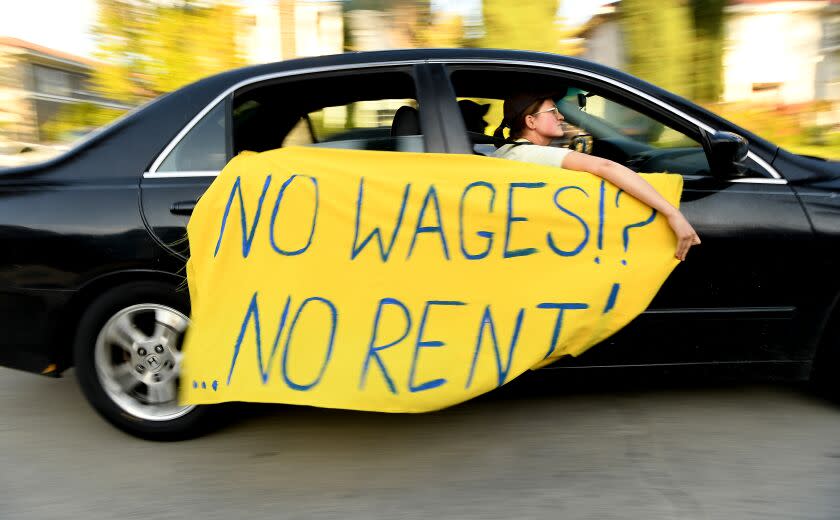What California renters can do now with eviction moratorium expired

Several deadlines and extensions have come and gone under California's COVID-19 eviction moratorium.
The statewide tenant protection for renters expired last week, two years after the first protections went into effect during the start of the pandemic. But a patchwork of moratorium extensions with municipalities throughout the state offer protection for some.
What happens now that California's eviction moratorium has ended?
Tenants across the state will need to figure out if their city or county offers some form of rent protection for nonpayment due to COVID-19. If a household can still get protection under their local moratorium, it does not mean they do not have to pay rent. Instead, their payments are deferred and will have to be paid later depending on the local rules, according to attorney Jeffrey Uno with Legal Aid Foundation of Los Angeles' Eviction Defense Center.
A landlord can still legally move ahead with the process to remove a tenant for nonpayment.
"Evictions are still proceeding. They have been proceeding throughout the pandemic, it's just that now the protections that some tenants enjoyed have gone away," Uno said. "People are confused or misinformed when they hear the word 'moratorium.' They think that they will not have to pay or they can ignore any type of legal documents from their landlords. Those people still have to respond if their landlord files the paperwork for the eviction process with the court."
Anyone experiencing loss of income due to COVID-19 should let their landlord know immediately with a declaration form provided by the state. Then those tenants should get proof that they submitted the declaration to their landlord, either through email, text or whatever other means they can to show they made that effort, Uno said.
What if a tenant applied for rent relief with the state, but hasn't received an official response?
California received $5.2 billion in federal aid last year to establish a rent relief program. The Department of Housing and Community Development was responsible for issuing about half of that money while local governments that chose to set up their own systems doled out the rest.
But the process to get renters that aid has been slow.
California's rent relief program has served nearly 340,000 households with an average payment of $11,684 for rent and utility assistance, according to the most recent data from the state.
Tens of thousands of tenants are still waiting to hear if their applications have been approved, according to the state agency. Tenants who are waiting should not sit on their hands, Uno said.
"Be diligent and follow up," Uno said. "Don't wait for them to call you. It could be a matter as simple as correcting a detail that the agency could claim was not verified. Whatever it might be, it's better to ask."
Approximately 13,000 applications are still being processed, Business, Consumer, Services and Housing Agency spokesperson Alicia Murillo said in a statement. That includes roughly 6,000 that are awaiting additional information from applicants, about 5,000 denials that are being appealed and approximately 1,500 renters who are waiting for utility assistance.
"By the June 30 expiration of statewide eviction protections, every eligible applicant who has been responsive to the program has been paid," Murillo said.
According to a June report from the National Equity Atlas, about 547,000 renter households applied for the program, but a little less than half received assistance and another 5% are still waiting for assistance.
Madeline Howard, senior attorney for the Western Center on Law and Poverty, is one of the attorneys in two lawsuits that a coalition of tenant advocacy groups brought against the Department of Housing and Community Development after it closed the application portal.
One lawsuit alleges that the state’s “flawed administration” of the rental assistance program “is violating tenants’ due process rights and disproportionately harming tenants on the basis of race, color, and national origin, leading to unnecessary evictions,” while another claims that the state isn’t covering the amount of rental debt promised by state law.
“I wish that things had gotten better,” Howard said. “The program has been deeply problematic from the beginning. ... This was a huge investment of public funds, and it could have made so much more of a difference and reached so many more vulnerable people than it did because of the way that it’s been handled.”
What about other parts of the state that still have moratoriums?
Evictions have skyrocketed in recent months, Uno said. In March, the California attorney general's office warned 91 law firms that represent landlords that some of their clients may have broken the law by filing false claims and pretending to be unaware of pending emergency rental assistance applications by their tenants.
Nailing down rent protections gets a bit trickier depending on where a person lives. The cities of Burbank and Glendale already lifted their eviction moratoriums, while the city of Los Angeles has moved to extend protection. Los Angeles County tenants who qualify will continue to see a rent moratorium through at least the end of the year. Every tenant should familiarize themselves with their local rent rules and protections, Uno said, because evictions are still going to be filed no matter what protections are in place.
A moratorium provides a defense for renters, but it doesn't mean that they are immune from eviction.
"It's happening every day," Uno said. "It's open season unfortunately for tenants."
Times staff writer Hannah Wiley contributed to this report.
This story originally appeared in Los Angeles Times.

